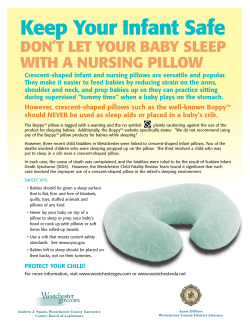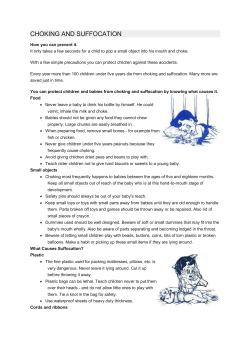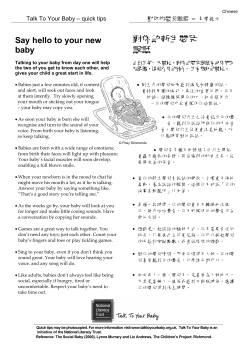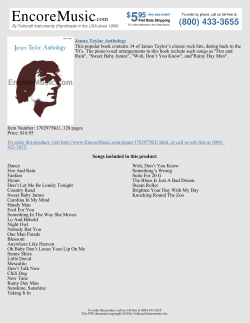
Document 165747
Safe Sleep for Your Baby zz ZZ z Please take a few minutes to read this important information on safe sleep practices. The Safe Sleep for Your Baby brochure provides parents and caregivers with information that can help babies sleep safely and lower the risk of Sudden Infant Death Syndrome, commonly known as SIDS. This publication was developed by the Public Health Agency of Canada. The Safe Sleep for Your Baby brochure is available at www.publichealth.gc.ca/safesleep Également disponible en français sous le titre : Sommeil sécuritaire pour votre bébé To obtain additional copies, please contact: Publications Health Canada PL 0900C2 Ottawa, Ontario K1A 0K9 Toll free.: 1-866-225-0709 Fax.: (613) 941-5366 E-mail: publications@hc-sc.gc.ca This publication can be made available in alternative formats upon request. © Her Majesty the Queen in Right of Canada, as represented by the Minister of Health, 2010 (Revised 2014) Pub.: 130522 Online: Cat.: HP15-8/2014E-PDF ISBN: 978-1-100-23092-4 Space for local health care centre or practitioners’ contact information: There are steps that you can take to help create a safe sleep environment for your baby and lower the risk of SIDS. Provide a smoke-free environment before an d after your baby is born. Breastfeeding can pr otect your baby. Always place your baby on his or her back to slee p, at naptime and night time. Provide your baby with a safe sleep environm ent that has a firm surface and no pillows, comforters, qu ilts or bumper pads. Place your baby to sle ep in a crib, cradle or bass inet next to your bed. Smoke-free Smoking during pregnancy exposes unborn babies to tobacco smoke which is one of the greatest risks for SIDS. Up to 1/3 of all SIDS deaths could be prevented if pregnant women did not smoke. No smoking at all is best for your baby, but lowering the amount of cigarettes you smoke can also lower the risk of SIDS. Second-hand smoke also increases the risk of SIDS after your baby is born. Avoid smoking near your baby—in the house, in the car or anywhere your baby sleeps or spends time. If you, your partner, family member or friends smoke, smoke outside and far away from your baby. Help to quit smoking is available from your health practitioner or by contacting the pan-Canadian quitline, toll-free at 1-866-366-3667 or www.gosmokefree.gc.ca/quit Breastfeeding Any amount of breastfeeding for any duration can help protect your baby from SIDS; but exclusive breastfeeding for the first 6 months (when the risk of SIDS is highest) can lower the risk of SIDS by up to 50%. Reminder: If you bring your baby into bed to breastfeed the risk of SIDS and suffocation do not increase so long as you place your baby back to sleep in a crib, cradle or bassinet after the feeding. Back to sleep Babies who always sleep on their backs have a lower risk of SIDS. Placing your baby on his or her back to sleep works; since the launch of the 1999 Back to Sleep campaign in Canada, the number of parents and caregivers who placed their babies on their backs to sleep increased dramatically and the rate of SIDS dropped by more than half. Newborn babies get in the habit of sleeping the way they are first placed, so start placing your baby on his or her back to sleep right after he or she is born. Sleep positioners, such as rolled up blankets or wedges, that are meant to keep babies on their backs to sleep are not needed and can increase the risk of suffocation. Supervised tummy time during play time is important to develop healthy muscles and helps to prevent your baby from developing plagiocephaly, also known as flat head. Reminder: Place your baby on his or her tummy 2–3 times a day soon after he or she is born. Slowly work your way up from 1 minute of tummy time, each time, until your baby can hold up his or her own head, often around 3–4 months. Why naptime and night time? Babies who usually sleep on their backs but are then placed on their tummies to sleep are at a much higher risk of SIDS. For this reason it is important that you, your partner, family, friends and caregivers know to always place your baby on his or her back to sleep—at home, in child care settings and when travelling. As babies get older they are usually able to turn over onto their tummies by themselves, often around 5 months. When this happens you do not need to reposition your baby onto his or her back to sleep. z zz z ZZ ZZ z z Safe sleep The safest place for your baby to sleep or nap is in a crib, cradle or bassinet that meets current Canadian safety regulations. When babies sleep in places that are not made for them, such as on an adult bed, sofa or armchair, they can become trapped and suffocate. The risk of suffocation is even higher if a baby shares the same sleep surface with an adult or another child. Safe sleep environment • Other than a firm mattress and a fitted sheet there is no need for any extra items in the crib, cradle or bassinet • Soft bedding, such as pillows, comforters, quilts and bumper pads, can increase the risk of suffocation • Soft surfaces, such as adult beds, sofas and armchairs, can increase the risk of suffocation Safe crib, cradle or bassinet • Check for a label that shows the date it was made. If it does not have a label, it may not be safe • Check regularly to make sure that the hardware is tight and not damaged • Health Canada only recommends cribs made after September 1986 and/or no more than 10 years old To learn more about crib, cradle and bassinet safety, please visit Health Canada Consumer and Product Safety at www.hc-sc.gc.ca/cps-spc/child-enfant/ equip/_crib-berc-eng.phphealthcanada.gc.ca/cps Baby swings, bouncers, strollers and car seats are not made for unsupervised sleep. Sleeping in a sitting position can cause your baby’s head to fall forward which can make it hard for your baby to breathe. For this reason it is important to move your baby to a crib, cradle or bassinet to sleep or when you arrive at your destination. Overheating is a risk for SIDS • Your baby is safest when he or she sleeps in fitted one-piece sleepwear that is comfortable at room temperature and does not cause your baby to overheat • If the room temperature is comfortable for you, then it is comfortable for your baby • Babies do not need extra blankets because a baby’s movements can cause their head to become completely covered, which can cause them to overheat Reminder: If a blanket is needed, your baby is safest with a thin, lightweight and breathable blanket. Crib, cradle or bassinet next to your bed Room sharing for the first 6 months (when the risk of SIDS is highest) helps your baby sleep safely and lowers the risk of SIDS. Room sharing means placing your baby to sleep in a crib, cradle or bassinet next to your bed, in your room. Bed sharing or co-sleeping, is when a baby shares the same sleep surface such as an adult bed, sofa or armchair, with an adult or another child. Sharing the same sleep surface increases a baby’s risk of SIDS and suffocation. This risk is even higher for babies less than 4 months old. Sharing the same sleep surface is unsafe because a baby can suffocate if: • he or she becomes trapped between the sleep surface and the body of an adult or another child, the wall or other objects • an adult or another child rolls over onto the baby; or • the sleep surface has soft bedding, such as pillows, comforters or quilts The risk of SIDS and suffocation is even higher if a baby shares the same sleep surface with a parent or caregiver who smokes, is very tired, or has taken drugs, alcohol or medications that can make them sleepy. Reminder: Room sharing makes it easier to breastfeed and check on your baby at night. Parents and all caregivers can create a safe sleep environment at home, in childcare settings and when travelling For additional information and resources on SIDS and Safe Sleep practices, please visit: The Public Health Agency of Canada at www.publichealth.gc.ca/safesleep
© Copyright 2025









